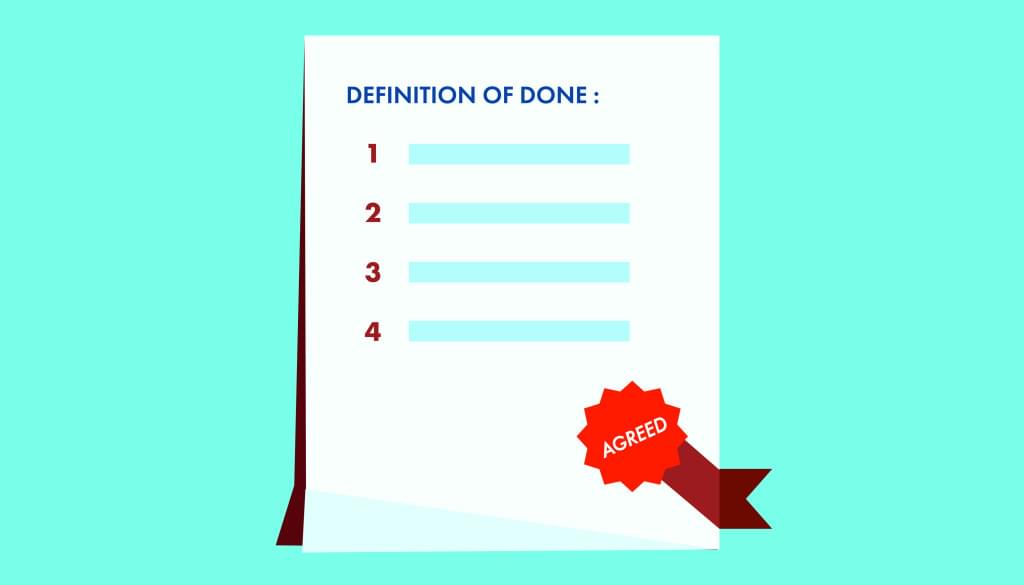
The following is an extract from our book, Scrum: Novice to Ninja, written by M. David Green. Copies are sold in stores worldwide, or you can buy it in ebook form here.
We’ve mentioned the definition of done a few times. The definition of done applies to each story in a sprint backlog. Declaring a story to be done is a means of verifying that all of its critical aspects have been completed based on the way each team works.
It’s vital for a team to have a shared idea of what done actually means for itself. Teams should create a written definition of done which they maintain as a checklist for every story they work on. This definition should be independent of the documentation for a specific story or project, because the definition of done should apply to the way a team works, independent of what they’re working on.
A definition of done is something the team should come up with together. It may be created during the first sprint planning, and iterated on during sprint retrospectives. A team’s definition of done may involve radically over time, as the team realizes during retrospectives what aspects of the process may need improvement.

It’s not a bad idea to publish the definition of done prominently. This allows people both on the team and outside the team to understand just how much effort is involved in completing any story. This document provides a reference point for questions about whether or not a proposed story is ready to be worked on. If it’s impossible for story to meet the definition of done based on the acceptance criteria, having a published definition of done can help the team make that clear.
Usually a definition of done includes a number of familiar expectations. For example, the code should be complete, the build shouldn’t fail, the test suite shouldn’t be broken, and the product should run as expected. Other points often included in a definition of done include peer reviewing code, writing new unit tests, code commenting, and updating product documentation. Different teams will have different requirements, and the exercise of creating a definition of done is valuable for helping the team realize what’s important for every story, not just certain stories.
Note: The Definition of Done Must Be Practical
While it’s important for a definition of done to be thorough, it’s also important that it’s practical. The definition of done must be achievable for every story. There may be practices the team believes should be followed for the sake of the codebase, but which are impractical given the constraints of the marketplace. Usually the engineers will argue for a more thorough scope, while the product owner may argue for a more streamlined approach, depending on the foresight of the product owner and the stability of the market. It’s up to each team to make their cases and come up with a definition of done that everybody can agree to before they start working.
Frequently Asked Questions (FAQs) about Scrum Artifacts and Definition of Done
What is the importance of Scrum Artifacts in Agile methodology?
Scrum Artifacts are essential components of the Agile methodology as they provide transparency and opportunities for inspection and adaptation. They are tools that provide information about the project, its progress, and the work that still needs to be done. They help in tracking progress, managing work, and ensuring everyone on the team has a clear understanding of the project’s status.
How does the Definition of Done (DoD) contribute to the success of a Scrum project?
The Definition of Done (DoD) is a critical aspect of Scrum projects. It serves as a checklist that ensures all necessary work has been completed before a product increment is considered “done”. It helps in maintaining the quality of work, reducing rework, and ensuring that the product meets the required standards and expectations.
Can the Definition of Done (DoD) change during a project?
Yes, the Definition of Done (DoD) can change during a project. However, it’s important to note that any changes should be agreed upon by the entire Scrum team. Changes to the DoD can occur as a result of lessons learned during the project, changes in the project scope, or changes in the team’s understanding of the product requirements.
What is the relationship between Scrum Artifacts and the Definition of Done (DoD)?
Scrum Artifacts and the Definition of Done (DoD) are closely related. The DoD is used to assess when a product increment, which is one of the Scrum Artifacts, is complete. The other Scrum Artifacts – the Product Backlog and the Sprint Backlog – are used to manage and track the work that needs to be done to reach the DoD.
How can Scrum Artifacts help in managing project risks?
Scrum Artifacts can help in managing project risks by providing transparency about the project’s progress and the work that still needs to be done. They allow the Scrum team to identify potential issues early, enabling them to take corrective action before these issues become significant risks.
What role does the Scrum team play in defining the Definition of Done (DoD)?
The Scrum team plays a crucial role in defining the Definition of Done (DoD). The team collaboratively decides on the criteria that must be met for a product increment to be considered “done”. This ensures that everyone has a shared understanding of what “done” means, which helps in maintaining the quality of work and reducing misunderstandings.
How often should Scrum Artifacts be updated?
Scrum Artifacts should be updated regularly to reflect the current state of the project. The Product Backlog is a living document that should be updated continuously as new information becomes available. The Sprint Backlog is updated daily during the Sprint to reflect the work that has been done and the work that still needs to be done.
Can a product increment be considered “done” if it does not meet all the criteria in the Definition of Done (DoD)?
No, a product increment cannot be considered “done” if it does not meet all the criteria in the Definition of Done (DoD). The DoD serves as a checklist that ensures all necessary work has been completed. If a product increment does not meet all the criteria in the DoD, it means that some work is still outstanding.
What happens if the Scrum team cannot agree on the Definition of Done (DoD)?
If the Scrum team cannot agree on the Definition of Done (DoD), it can lead to confusion, misunderstandings, and inconsistencies in the quality of work. It’s important for the team to have a shared understanding of what “done” means. If there are disagreements, the team should discuss and resolve them to ensure everyone is on the same page.
How can the Definition of Done (DoD) help in improving the efficiency of a Scrum team?
The Definition of Done (DoD) can help in improving the efficiency of a Scrum team by providing a clear and shared understanding of what needs to be done to complete a product increment. This reduces ambiguity, helps in planning and estimating work, and ensures that everyone is working towards the same goal. It also helps in maintaining the quality of work, reducing rework, and ensuring that the product meets the required standards and expectations.
I've worked as a Web Engineer, Writer, Communications Manager, and Marketing Director at companies such as Apple, Salon.com, StumbleUpon, and Moovweb. My research into the Social Science of Telecommunications at UC Berkeley, and while earning MBA in Organizational Behavior, showed me that the human instinct to network is vital enough to thrive in any medium that allows one person to connect to another.






